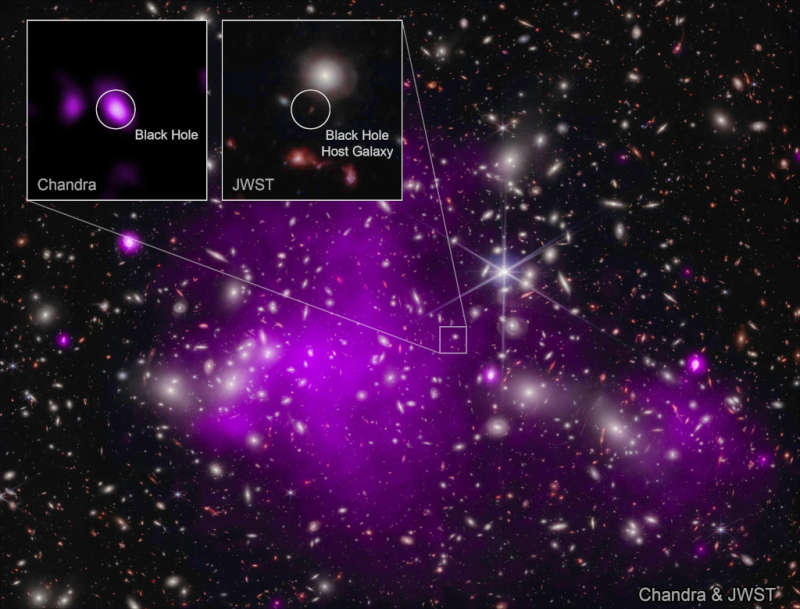
|
Credit & Copyright: X-ray:
NASA/CXC/SAO/÷kos Bogd÷n;
Infrared:
NASA/ESA/CSA/STScI;
Image Processing: NASA/CXC/SAO/L. Frattare & K. Arcand
Explanation:
Dominated by dark matter,
massive cluster of galaxies Abell 2744 is known to some as
Pandora's
Cluster.
It lies 3.5 billion light-years away toward the constellation Sculptor.
Using the galaxy cluster's enormous mass as a gravitational lens
to warp spacetime and magnify even more distant objects
directly behind it, astronomers
have found a background galaxy, UHZ1, at a
remarkable
redshift of
Z=10.1.
That puts UHZ1 far beyond Abell 2744,
at a distance of 13.2 billion light-years, seen when
our universe was about 3 percent of its current age.
UHZ1 is identified in
the insets
of this composited image combining X-rays (purple hues) from the
spacebased Chandra X-ray Observatory and
infrared light from the James Webb Space Telescope.
The X-ray emission from UHZ1 detected in the Chandra data is
the telltale signature of a growing supermassive black hole
at the center of the ultra high redshift galaxy.
That makes UHZ1's growing black hole the most
distant black hole ever detected in X-rays,
a result that now hints at how and when the first supermassive
black holes in the universe formed.
Image Processing: NASA/CXC/SAO/L. Frattare & K. Arcand
|
January February March April May June July August September October November December |
| ||||||||||||||||||||||||||||||||||||||||||||||||
NASA Web Site Statements, Warnings, and Disclaimers
NASA Official: Jay Norris. Specific rights apply.
A service of: LHEA at NASA / GSFC
& Michigan Tech. U.
Based on Astronomy Picture
Of the Day
Publications with keywords: cluster of galaxies - black hole
Publications with words: cluster of galaxies - black hole
See also:
- APOD: 2025 December 3 ┴ Visualization: Near a Black Hole and Disk
- APOD: 2025 September 24 ┴ GW250114: Rotating Black Holes Collide
- APOD: 2025 May 9 ┴ IXPE Explores a Black Hole Jet
- APOD: 2025 May 6 ┴ The Doubly Warped World of Binary Black Holes
- APOD: 2025 May 4 ┴ Spin up of a Supermassive Black Hole
- APOD: 2024 November 24 ┴ Journey to the Center of the Galaxy
- APOD: 2024 October 1 ┴ Porphyrion: The Longest Known Black Hole Jets
